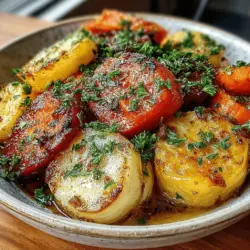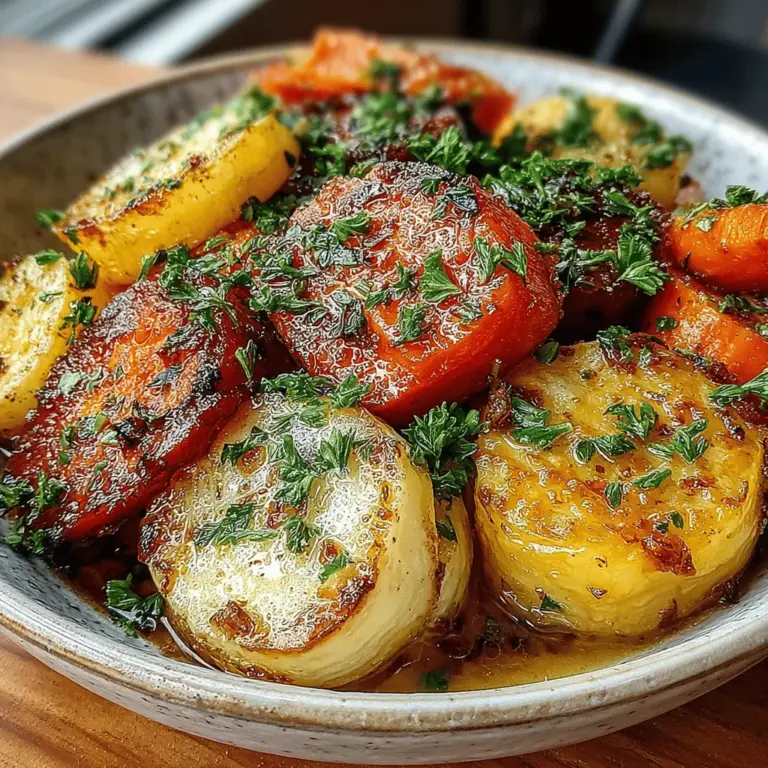Maple Glazed Carrots and Parsnips: A Deliciously Wholesome Recipe
When it comes to side dishes that elevate a meal, few can compete with the vibrant and delectable combination of maple glazed carrots and parsnips. This dish is not only visually appealing, with its rich colors and glossy finish, but it also brings a delightful medley of flavors to the table. The sweet, earthy tones of the vegetables complement the warm, rich notes of maple syrup, creating a harmonious balance that tantalizes the palate. Ideal for holiday gatherings, family dinners, or even a simple weeknight meal, this recipe is sure to impress both guests and family alike.
The Significance of Seasonal Vegetables
One of the most appealing aspects of this dish is its reliance on seasonal vegetables. Carrots and parsnips thrive in cooler weather, making them a staple in fall and winter cuisine. Utilizing seasonal produce not only ensures the vegetables are at their peak flavor and nutritional value, but it also supports local farmers and reduces the carbon footprint associated with long-distance transportation. By choosing fresh, in-season carrots and parsnips, you can enhance the overall quality of your dish while enjoying the health benefits they offer.
Health Benefits of Carrots and Parsnips
Both carrots and parsnips are nutritional powerhouses packed with essential vitamins and minerals. Carrots are well-known for their high beta-carotene content, which the body converts into vitamin A. This nutrient is crucial for maintaining good vision, boosting the immune system, and promoting healthy skin. Additionally, carrots are a great source of fiber, which aids in digestion and contributes to overall gut health.
Parsnips, on the other hand, offer a unique set of benefits. They are rich in vitamins C and K, as well as folate, which is necessary for cell division and overall health. Parsnips are also a good source of dietary fiber and antioxidants, making them an excellent addition to a balanced diet. Together, these root vegetables provide a nutritious and wholesome component to any meal.
Exploring the Maple Glaze
At the heart of this recipe lies the maple glaze, a delightful concoction that brings a unique flavor profile to the dish. Maple syrup, derived from the sap of maple trees, offers a natural sweetness that is distinct from refined sugars. Its rich, caramel-like taste enhances the earthy flavors of carrots and parsnips, providing a depth that elevates the entire dish. Beyond its delicious taste, maple syrup contains beneficial antioxidants and minerals, including manganese and zinc, which contribute to overall health.
The addition of a maple glaze not only enhances flavor but also adds a glossy finish that makes the dish visually appealing. This touch of sweetness works wonders when balanced with spices and herbs, allowing the natural flavors of the vegetables to shine through while adding an element of complexity.
Understanding the Ingredients
To create the perfect maple glazed carrots and parsnips, it’s essential to understand the key ingredients that make this dish shine.
Carrots: When selecting carrots, look for firm, smooth-skinned vegetables with vibrant color. Smaller carrots tend to be sweeter and more tender, while larger ones may have a stronger flavor. Nutritionally, carrots are low in calories yet high in essential nutrients, making them a perfect addition to any meal.
Parsnips: Parsnips are similar in shape to carrots but have a creamier hue and a slightly nutty flavor. They can be a bit starchier than carrots, which adds a satisfying heartiness to the dish. When choosing parsnips, opt for smaller, younger specimens as they tend to be sweeter and more tender.
Maple Syrup: The star of the show, maple syrup should be 100% pure for the best flavor and health benefits. Look for grade A or grade B options, as these have richer flavors that enhance the dish.
Fresh Herbs: Adding fresh thyme not only brings an aromatic quality but also complements the sweetness of the glaze beautifully. Thyme’s earthy notes create a balanced flavor profile that enhances the overall dish.
Optional Ingredients: For added depth, consider incorporating vegetable or chicken broth into the recipe. This can enhance the savory notes of the dish, creating a more complex flavor experience.
Preparation Method
Now that we’ve covered the ingredients, let’s dive into the initial preparation steps to create your maple glazed carrots and parsnips.
1. Prepping the Vegetables: Start by thoroughly washing your carrots and parsnips to remove any dirt. Peel both vegetables using a vegetable peeler, taking care to remove any blemishes.
2. Uniform Slicing: For even cooking, it’s crucial to slice the carrots and parsnips uniformly. Aim for pieces that are about the same thickness—around 1/2 inch thick works well. This will ensure that they cook evenly, allowing for a consistent texture throughout the dish.
3. Selecting the Best Produce: When shopping for carrots and parsnips, always look for firm vegetables without soft spots or cracks. The fresher the produce, the better the flavor, and this is particularly important when preparing a dish that relies on the natural sweetness of these vegetables.
4. Sautéing the Vegetables: Heat a large skillet over medium heat and add a tablespoon of olive oil or butter. Once the fat is hot, add the sliced carrots and parsnips. Sauté for about 5-7 minutes, stirring occasionally, until the vegetables start to soften and develop a slight caramelization.
5. The Science Behind Sautéing: Sautéing not only cooks the vegetables but also enhances their flavors through a process called the Maillard reaction. This is where the natural sugars in the vegetables caramelize, developing richer flavors and a pleasing aroma.
6. Visual Cues: Keep an eye on the vegetables as they cook. Look for a golden-brown color on the edges, which indicates that they are caramelizing nicely. This step is crucial for building a depth of flavor that will be further enhanced by the maple glaze.
7. Incorporating Spices and Maple Syrup: Once the vegetables have reached the desired level of caramelization, it’s time to add your spices. A pinch of cinnamon can be a delightful addition, enhancing the sweetness of the maple glaze and providing a warm, comforting note.
8. Balancing Sweetness with Spices: The key to a successful maple glaze is balancing the sweetness of the maple syrup with savory and spicy elements. Add the syrup to the skillet, stirring gently to coat the vegetables evenly. This is where the magic happens, as the syrup melds with the sautéed carrots and parsnips, creating a glossy finish.
As you embark on the journey of crafting this delightful maple glazed carrots and parsnips dish, you’ll not only enjoy the process but also the satisfaction of serving a meal that is both nutritious and full of flavor. Stay tuned for the caramelization process, where we will delve deeper into enhancing the dish’s overall appeal.
{{image_2}}
Understanding Caramelization and Its Importance
Caramelization is the process of cooking sugar until it transforms into a rich, golden syrup, deepening in flavor and complexity. In the context of Maple Glazed Carrots and Parsnips, caramelization is essential. As the natural sugars in the carrots and parsnips cook, they begin to caramelize, creating a sweet, savory glaze that enhances the vegetables’ inherent flavors. This process not only adds depth to the dish but also creates a beautiful glossy finish that makes it visually appealing.
When caramelizing vegetables, it’s crucial to maintain the right cooking temperature. Cooking over medium heat allows the sugars to caramelize gently without burning, which can lead to bitterness. The right timing and patience are key to achieving that perfect balance of sweetness and texture, making your glazed vegetables irresistible.
Cooking Time and Techniques to Prevent Sticking
Achieving perfectly glazed carrots and parsnips requires attention to cooking time and techniques to prevent sticking. Start by heating your skillet or roasting pan over medium heat before adding the vegetables. This helps to ensure even cooking and reduces the likelihood of the vegetables sticking to the pan.
When cooking, stir the vegetables occasionally. This not only promotes even cooking but also helps prevent them from adhering to the pan’s surface. If you notice that the vegetables are beginning to stick, add a splash of vegetable broth or water. This will create steam that helps lift the vegetables off the pan while also adding moisture to the dish.
Cooking times may vary depending on the size of the vegetable pieces. Generally, it takes about 20-25 minutes to achieve perfectly glazed carrots and parsnips. Aim for a fork-tender texture without overcooking, which can lead to mushy vegetables.
The Role of Broth in Achieving a Rich Glaze
Incorporating vegetable broth into your Maple Glazed Carrots and Parsnips recipe is a game-changer. The broth not only adds moisture but also enriches the flavor profile, creating a more complex and savory glaze. As the broth reduces during cooking, it enhances the sweetness of the maple syrup and intensifies the overall flavor.
To use broth effectively, add it in small increments, allowing it to reduce before adding more. This method helps concentrate the flavors and prevents the dish from becoming watery. The result is a beautifully glazed side dish that is both sweet and savory, perfect for complementing a variety of mains.
Tips for Ensuring Vegetables Are Perfectly Cooked
To achieve the ideal texture in your glazed carrots and parsnips, it’s essential to understand the difference between fork-tender and overcooked vegetables. Fork-tender means that the vegetables are soft enough to be easily pierced with a fork while still retaining their shape. Overcooked vegetables, on the other hand, can become mushy and lose their vibrant color and flavor.
To ensure perfect cooking, cut your carrots and parsnips into uniform sizes. This promotes even cooking and minimizes the risk of some pieces becoming overcooked while others are still firm. Start checking for doneness around the 15-minute mark, and continue to cook until they reach your desired tenderness.
Finishing Touches
Adding Thyme at the End of Cooking
The addition of fresh thyme at the end of cooking is crucial for enhancing the flavor of Maple Glazed Carrots and Parsnips. Thyme adds an aromatic note that complements the sweetness of the glaze, creating a well-rounded dish.
Fresh herbs like thyme are delicate and can lose their flavor when cooked for extended periods. By adding them towards the end, you preserve their freshness and aromatic qualities, resulting in a more vibrant dish.
The Contribution of Fresh Herbs to Aroma and Flavor
Fresh herbs can transform a dish, adding layers of flavor and a delightful aroma. Not only does thyme enhance the taste, but it also provides a visual contrast to the vibrant orange and yellow of the carrots and parsnips. Consider garnishing your dish with additional fresh herbs, such as parsley or chives, for an extra pop of color and flavor.
Importance of Garnishing with Parsley
Garnishing with fresh parsley serves a dual purpose. It not only enhances the presentation of your Maple Glazed Carrots and Parsnips but also adds a refreshing note that cuts through the sweetness of the glaze. The bright green color of parsley contrasts beautifully with the warm tones of the glazed vegetables, making the dish more appealing.
To garnish, simply chop fresh parsley finely and sprinkle it over the dish just before serving. This final touch elevates the dish’s appearance and flavor profile, making it a standout on any table.
Serving Suggestions
Ideal Pairings for Maple Glazed Carrots and Parsnips
Maple Glazed Carrots and Parsnips are a versatile side dish that pairs well with various proteins and vegetarian options. For a hearty meal, consider serving these glazed vegetables alongside roasted chicken, pork tenderloin, or even a flavorful beef roast. The sweetness of the glaze complements the savory notes of these proteins, creating a harmonious balance on the plate.
For vegetarian options, serve the glazed vegetables alongside grain-based dishes such as quinoa or farro, or pair them with a hearty lentil stew. The combination of flavors will create a satisfying and wholesome meal.
Meal Occasions: Holiday Dinners, Weeknight Meals, and More
Maple Glazed Carrots and Parsnips are perfect for various meal occasions. They make a festive addition to holiday dinners, complementing traditional dishes like roast turkey or ham. Their vibrant color and sweet flavor make them an appealing choice for gatherings and celebrations.
On weeknights, this recipe is quick and easy to prepare, allowing you to enjoy a delicious homemade meal without spending hours in the kitchen. The simple steps and minimal ingredients make it an ideal side dish for everyday meals, ensuring that you can enjoy wholesome flavors even on busy nights.
Incorporating This Dish into a Balanced Diet
This dish is an excellent way to incorporate more vegetables into your diet while enjoying the natural sweetness of carrots and parsnips. The use of maple syrup as a natural sweetener provides a healthier alternative to refined sugars, offering a delightful taste without the guilt.
Pairing these glazed vegetables with whole grains and lean proteins ensures a well-rounded meal that is both satisfying and nutritious. By including a variety of vegetables in your diet, you can reap the benefits of essential nutrients, fiber, and antioxidants.
Nutritional Information
Breakdown of Calories and Nutrients per Serving
Each serving of Maple Glazed Carrots and Parsnips is approximately 100-120 calories, depending on the amount of maple syrup used. This dish is rich in vitamins and minerals, making it a healthy addition to your meal plan.
Discussion on the Health Benefits of the Dish
Carrots and parsnips are packed with nutrients. Carrots are an excellent source of beta-carotene, which is converted into vitamin A in the body, promoting eye health and boosting the immune system. Parsnips provide a good source of vitamin C, folate, and various antioxidants, contributing to overall health.
Fiber Content from Vegetables
Both carrots and parsnips are high in dietary fiber, which is essential for digestive health. Consuming fiber-rich foods can help regulate blood sugar levels, lower cholesterol, and promote feelings of fullness, making them an excellent addition to a balanced diet.
Antioxidants and Vitamins Present in Carrots and Parsnips
The vibrant colors of carrots and parsnips indicate their rich antioxidant content. Antioxidants help combat oxidative stress in the body, reducing inflammation and lowering the risk of chronic diseases. Incorporating these vegetables into your meals is a delicious way to boost your antioxidant intake.
Advantages of Using Maple Syrup as a Natural Sweetener
Using maple syrup in this recipe not only adds sweetness but also provides a unique flavor profile that enhances the dish. Unlike refined sugars, maple syrup contains minerals like manganese and zinc and has a lower glycemic index, making it a healthier alternative.
Conclusion
Maple Glazed Carrots and Parsnips offer a delightful balance of sweetness and savory flavors that make them an appealing side dish for any occasion. Their versatility allows them to complement a wide range of proteins and vegetarian options, making them suitable for holiday celebrations, weeknight meals, and everything in between.
By trying this recipe, you can enjoy the unique flavors of seasonal ingredients while exploring your creativity in the kitchen. Don’t hesitate to experiment with variations, such as adding different herbs or spices to elevate the dish further.
Embrace the joy of cooking with fresh, seasonal ingredients and the simple pleasures of homemade meals. You’ll find that preparing this delightful dish not only nourishes the body but also brings satisfaction and warmth to the dining experience. Enjoy the process and savor the rewards of your culinary creations!


